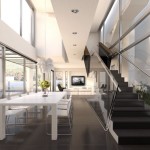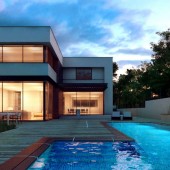8 Amazing Matte Painting Videos by Gordon Tarpley
I recently joined the CG Architecture group over at flickr, and this gorgeous image catched my attention today. The great thing about it and other images by Gordon Tarpley is that he kindly composed the process of his work from initial rendering to final image. These videos are very inspirational and are a rich source of information about how to postwork a render and add people, vegetation and amend it in many ways to achieve the desired and result.
Loby Visualization from Gordon Tarpley on Vimeo.
Living Room Visualization from Gordon Tarpley on Vimeo.
Initial modeling done by coworker. final modeling (client changes), lighting, rendering, composting/digital painting done by me.Gordon Tarpley
Pool Deck Visualization from Gordon Tarpley on Vimeo.
For this shot my job was to paint the surrounding buildings to be a night scene. It originally was a daylight satellite photo but some of my adjustments were already flattened in the first frame of this animation. There are CG massing models of the city laid over the satellite photo. the CG elements in the middle were put together by a team of co-workers and dropped onto my backplate by someone other than me.Gordon Tarpley
Aerial View digimatte from Gordon Tarpley on Vimeo.
Arichitectural Exterior Visualization from Gordon Tarpley on Vimeo.
This is the backplate for an illustration done at work. The shot was initially finished as a day shot but the client decided they wanted to change it to dusk. My task was changing the time of day and cleaning up/modifying some of the foreground elements for the plate. The 3d elements (not shown) were handled by a coworker. The rendered elements for this image have been excluded and actually cover the lower buildings toward the middle of the image. When the final composite is okay to show the public I’ll post a link to the image.Gordon Tarpley
Day to Dusk Matte from Gordon Tarpley on Vimeo.
This dining space was created in 3d studio max and rendered in vray (scene modeled by Robert Rodriguez, Lighting, rendering, composting and digital painting done by Me),due to short turn-around time, and lack of background imagery at render time, the scene was set up with very generic lighting to give more flexibility in post. Loads of photoshop painting was done to get the final image.Gordon Tarpley
Arichitectural Visualization Composite Build-up from Gordon Tarpley on Vimeo.














First one is amazing! some other are less. Intresting to see that we all seem to share the same techniques. Would be intresting to see detailed explanations of some parts of the process.
Very interesting indeed! Gordon works at StudioAMD and it is nice to see how some of their production images are made… it seems a lot is left for post, more then I would have thought.
I guess this saves a great amount of time then doing it all in render, and also when revisions are needed. I can also see how this can be more artistically productive as you can explore many options in a painting style instead of the limits of re-rendering again and again.
As much as I want to do it all in render, like peter for example usually does… I tend to prefer this method of work.
Great find Ronen, I remember just not so long ago, this kind of detailed breakdown of a rendering was kept in secret.
It is true, most of the 3D firms follow the same technique, because it saves time fixing client’s comments. But this technique has more of a matte painting finish to it and is a bit old-school. Sometimes the renderings I see from well known firms end up looking a bit flat, especially the trees. The firms I used to work at exploited this technique a lot, sometimes to the point of using scan-line render to get just a shape of the building and then matte-paint everything in, including reflections and such.
i can only second this.
in a normal image creation process we use roughly 50% of the project time for 3d and the remaining 50% for 2d post work.
most important are good channels and the ability to render out ‘tools’ for the post process.
well, thanks for the links – quite interesting 🙂
wow! thanks for posting my videos!
Thanks goes to you Gordon for sharing your technique the way you did! It’s always nice to see how others go about creating their artwork.
Thank you. Interesting video.